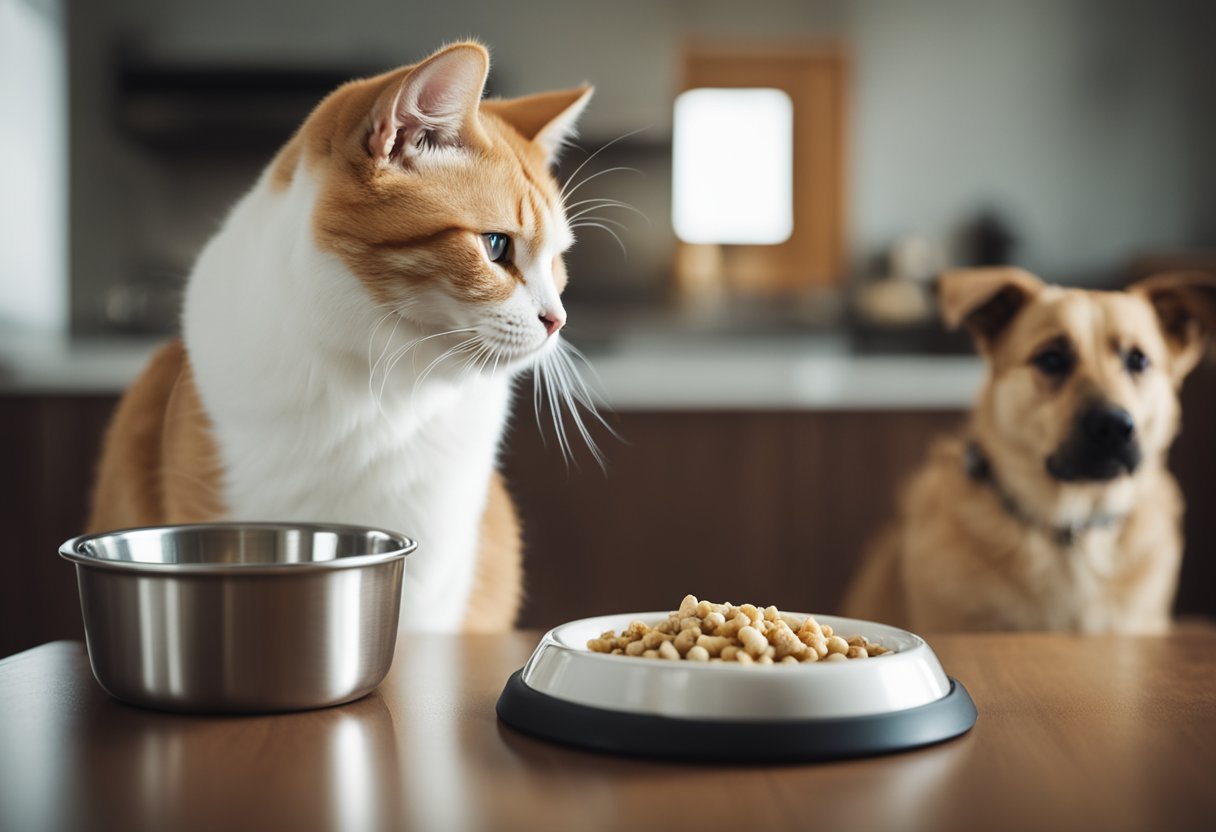As dedicated pet owners, we often go to great lengths to ensure our furry companions are happy and healthy. But just like humans, pets can fall victim to weight gain, which can lead to a slew of health issues. Monitoring our pets’ weight isn’t just about aesthetics; it’s a crucial aspect of their overall well-being. While it may seem daunting at first, understanding that weight loss in pets is manageable and, in many cases, absolutely necessary is the first step we can take towards helping them.

In today’s world of ever-advancing technology, smart devices have crept into the pet care niche, offering innovative ways to keep track of our pets’ fitness and dietary habits. From automatic feeders that dispense the perfect amount of food to activity trackers that monitor exercise, we’re now armed with the tools to create a detailed and effective weight loss plan. Let’s use these smart devices to stay on top of our pets’ health, making sure we can enjoy their companionship for as long as possible.
Key Takeaways
- Addressing pet obesity is crucial for their health and longevity.
- Smart devices can aid in creating and following a tailored weight loss plan.
- Ongoing monitoring and adjustments ensure long-term weight management.
Understanding Pet Weight Loss
It’s important for us to understand that maintaining a healthy weight is as crucial for our pets as it is for us. With smart pet devices entering the scene, we have innovative ways to monitor and manage our pets’ health. These devices can track activity levels and help us customize feeding schedules and portions, directly affecting our furry friends’ weight.
Causes of Weight Gain in Pets
Weight gain in pets can stem from a variety of factors. Ensuring proper nutrition and exercise is where smart devices shine. Here’s a brief overview:
- Overfeeding: Automatic feeders with portion control can prevent us from giving our pets too many calories.
- Lack of Exercise: Activity monitors help us keep tabs on their movement, nudging us to increase playtime if necessary.
The advent of smart toys also contributes to keeping our pets active, which can keep those extra pounds at bay.
Health Risks of Obesity
Obesity can lead to serious health complications for our pets.
- Diabetes: Much like in humans, obesity in pets can increase the risk of diabetes. By using smart glucose monitors, we can keep an eye on their levels.
- Joint Problems: Excess weight puts extra stress on joints. Smart collars can alert us to changes in our pet’s movement, indicative of pain or discomfort.
By leveraging smart technology, we can better manage our pets’ weight, ensuring they live happy, healthy, and active lives.
Creating a Weight Loss Plan
Embarking on a weight loss journey for our furry friends requires commitment and careful planning. We know it can be challenging, but with the right approach, our pets can achieve healthier weights. Let’s embark on this transformation by setting clear objectives, making smart dietary adjustments, and engaging in fun, effective exercise routines.
Setting Realistic Goals
Initiating a weight loss plan starts with setting realistic, achievable goals. It’s important for us to consult with a veterinarian to establish a safe and effective weight loss target, typically aiming for a gradual loss of 1-2% of body weight per week. Keeping in mind the specific needs of our pets, we’ll craft a plan that is tailored to their individual requirements.
Dietary Changes for Weight Loss
Next, we focus on dietary changes. Cutting back on calories while maintaining nutrition is key. Smart pet devices can help us monitor food intake and ensure our pets are fed the correct portions. Swapping out high-calorie treats with healthy alternatives is another strategy we will implement. We can use smart feeders to control portions and feeding times, preventing overeating and helping our pets adjust to their new diet seamlessly.
- Replace high-fat treats with low-calorie vegetables
- Use a smart feeder to control portion sizes
- Monitor progress with a pet weight tracking app
Exercise Strategies for Pets
For the exercise part of our plan, incorporating regular activity into our pet’s routine is a must. Technology can be an ally here through the use of devices such as interactive toys or apps that encourage movement and play. An effective program will be tailored to the pet’s current fitness level and will increase in intensity as their endurance improves.
- Start with short walks, gradually increasing the duration
- Engage in play with smart toys that encourage activity
- Track activity levels with a pet fitness tracker
By adhering to these focused strategies, we’ll help our pets shed the extra pounds and move towards a healthier lifestyle.
Monitoring Progress

When we embark on the journey of helping our pets lose weight, it’s crucial that we keep track of their progress. By regularly monitoring their weight, we can make necessary adjustments to their diet and exercise plans. Let’s make sure we’re taking the right steps in supporting our furry friends’ path to a healthy lifestyle.
Regular Weigh-Ins
To ensure we are on the right track, weekly weigh-ins are essential. It’s just like using a smart scale for our own health routine. We can either invest in a pet-specific smart scale to keep at home or schedule regular visits at the vet’s office. This data allows us to see the trend in weight change and respond accordingly.
- Weigh the same day each week: Consistency is key.
- Record the weight: Use an app or a smart device that tracks pet health data.
Adjusting the Weight Loss Plan
If the weigh-ins reveal that our pet is not losing weight at the ideal rate, we must adjust the plan. It’s like fine-tuning a piece of sophisticated technology; we must tailor the input—food and activity—to get the desired output.
- Increase their activity subtly: Incorporate more playtime or walks.
- Modify their intake: Consult a vet to safely alter their diet.
By following these steps and utilizing the help of smart devices designed for our pets, we can make weight loss a successful and healthy endeavor.
Weight Maintenance

When managing our pets’ weight, we must focus on two core principles for success: precise dietary management and a consistent exercise routine. These aspects are not quick fixes but lifelong commitments to ensure our furry friends stay happy and healthy.
Long-Term Dietary Management
We understand that selecting the right food for your pet is crucial in weight maintenance. It’s like choosing the best fuel for a machine—quality matters. For long-term success:
- Frequency: Aim to feed meals at the same time every day to maintain a routine.
- Portion Control: Be meticulous about portion sizes according to your pet’s specific needs.
- Nutrient Balance: Your dog’s diet should be high in protein and fiber but low in fat.
Transitioning to a weight management diet should be gradual to avoid digestive upset. Here’s a guide to transitioning your pet’s food safely:
- Days 1-2: 75% old food, 25% new food.
- Days 3-4: 50% old food, 50% new food.
- Days 5-6: 25% old food, 75% new food.
Stick with the plan, and adjust as needed based on your pet’s progress.
Continued Exercise Regimen
Regular exercise is the other half of the weight maintenance equation. A good exercise regimen not only helps control weight but also improves mental health and overall well-being. Here’s how to stay the course:
- Consistency: Schedule daily walks or playtime—rain or shine.
- Variety: Keep things interesting with different activities. Smart devices like interactive toys can make exercise feel like a fun game.
- Monitoring: Invest in a pet activity tracker to monitor your pet’s fitness progress and keep you both motivated.
Remember, exercise is as crucial as diet and should never be overlooked.
Professional Guidance
We understand your concern when it comes to your pet’s weight, and we’re here to guide you through the journey to healthier living for your furry friends. If you’re noticing that your pet’s smart collar is indicating less activity or if their smart feeder is dispensing more food than their diet requires, it’s time to consider professional guidance for weight loss. Our goal is to help you every step of the way.
When to Consult a Veterinarian
Weight changes in your pet might be subtle at first, but our connected devices help in monitoring these variations. When you observe consistent alerts from your pet’s weight tracking tools, or if their activity levels have decreased on their smart devices, it’s crucial to consult a veterinarian. A professional can provide a detailed health assessment, tailored to your pet’s individual needs, and can rule out any underlying health issues contributing to weight gain.
- Consult if:
- Your pet’s smart collar indicates decreased activity for over two weeks.
- The smart feeder consistently reports overfeeding.
Role of Pet Nutritionists
Once under a vet’s care, it might be recommended to work with a pet nutritionist. These specialists use data from your pet’s smart devices, like the calorie consumption tracked by their smart feeder, to create a precise feeding plan. A pet nutritionist can provide guidance on adjusting portion sizes and selecting the best weight management food that interacts seamlessly with your smart devices.
- Pet nutritionists can:
- Customize meal plans using data from smart feeders.
- Recommend specific food types that work well with your pet’s feeding and activity trackers.
Frequently Asked Questions

We know how important your pet’s health is, and weight management plays a crucial role. That’s why we’re addressing some common queries you might have, helping you take actionable steps toward a healthier lifestyle for your furry friend. We’ve gathered insights on exercises, diet changes, breed-specific considerations, and more to give your pet the best chance at reaching their ideal weight.
What are some effective exercises for helping my dog slim down?
Exercise is crucial in managing your dog’s weight. Activities such as brisk walking, swimming, or playing fetch can help your dog burn calories and improve cardiovascular health. Incorporating interactive smart devices for pets can also provide engaging ways to get them moving more often.
Can changing my dog’s diet lead to successful weight loss?
Certainly, diet plays a key role in weight loss. High-protein, low-fat dog foods often support weight reduction while maintaining lean muscle mass. Consult a veterinarian before altering your dog’s diet or consider using a smart pet feeder to control portions and monitor their caloric intake.
Are there specific breeds that are more prone to obesity and require different weight loss strategies?
Yes, some breeds, like Labradors and Pugs, are more susceptible to obesity. They may require a tailored exercise and diet plan. Understanding your pet’s breed-specific needs is essential, and employing weight management tools tailored to your pet’s breed can be effective.
How can I determine the ideal weight range for my pet?
Your pet’s ideal weight depends on their breed, age, and size. It’s best to consult with a veterinarian who can assess your pet’s health and provide a target weight range. Smart scales designed for pets can help you track your pet’s progress accurately.
What health risks are associated with obesity in pets?
Obesity can lead to several health issues, such as diabetes, heart disease, and joint problems. Maintaining a healthy weight is critical to avoid these conditions. Utilizing smart pet health monitoring devices allows us to stay aware of any concerning health metrics.
How often should I weigh my pet during a weight loss program?
We recommend weighing your pet once every two weeks to monitor their progress. It’s important not to make drastic changes based on daily fluctuations but to observe the trend over time. Consistent monitoring using a pet-specific scale can help us gauge the effectiveness of our weight loss strategy.

